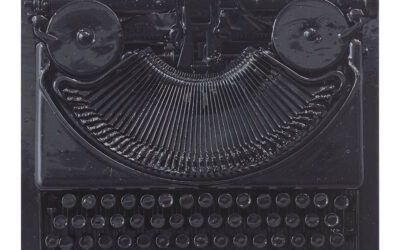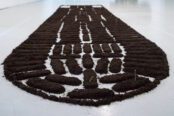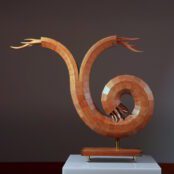Typical. You wait all year for an album playing on the sound of the internal mechanisms of the piano, and then two turn up within a fortnight.
On first impressions, Kid Koala's Space Cadet sounds distinctly like it is exploring the same concepts as Nils Frahm's Felt. There is the same spare piano work, the microphones placed close to the instrument's strings so as to pick up the secondary noises generated by keystrokes and returns. Whichever of the two came up with the idea first is irrelevant though, because as Space Cadet develops, it becomes obvious that apart from that single stylistic overlap, there is no need to fear some sort of keyboardist conspiracy: the two are very different albums.
Whilst the piano technique may not show much overt dexterity, the turntables are clearly attended to by a master
Despite the piano being the principal instrument in the Kid Koala album, mixed to the middle of the sound panorama and louder than any of the other components of the record, it is in the use of turntables where the recording shines. Whilst the piano technique may not show much overt dexterity, the turntables are clearly attended to by a master. Mixed almost out of earshot at times, and almost never drawing the listener's full concentration, the scratching that makes up the sonic foundation of Space Cadet is manic at times, utterly captivating in its simplicity at others. On 'Return', it figures simply as the light crackle and recurring click of the run-out groove on an LP. It is one of the most evocative of sounds, and in this instance conveys solitary contemplation, even alienation.
Warning. The record is released with a graphic novel. Or, if you prefer, the graphic novel is released with a record. Such multimedia ambitions can be a distraction. In this case, the final sentence of that last paragraph is subject to much interpretation. Listened to as a piece of audio, the crackling run-out groove is comforting, a warm reminder of music as psychoanalysis; of the joy and succour to be had from listening closely to a piece of music on a format that is not as disposable as mp3, and which demands an emotional and physical engagement from the listener. It is, musically, a moment of calm resignment, stocism and ultimately, hope.
Read the graphic novel though, and an entirely different cast appears on the mood. The crippling pathos of the story, conveyed entirely through white-on-black etchings, infects the reception of the music profoundly. Where the standalone audio develops an intimacy through the sheer closeness of that piano, with the additional sound components suggesting disturbing external forces and themes, its abiding tone is one of hope. Fragile hope, and subject to great stress, but hope nonetheless.
The crippling pathos of the story, conveyed entirely through white-on-black etchings, infects the reception of the music profoundly
Listened to in tandem with the imagery though (and the documentation states clearly that the record is to be used as a soundtrack), it is difficult to be convinced by that sense of hope. Some of the nuances of the music tend to get hammered into submission by the dominance of the visual. Particularly the sense of stoic resilience that is fuelled by small but intense sparks of light (single keyboard notes, ascending in slow arpeggio). It's the defining theme of the music, but it is simply obliterated by the visuals – mutating into a much cruder doomed pathos, stripped of its more subtle emotional expression.
But how striking to come across a piece of music which lends itself to such interpretations. What luxury, to fret over which nuances of tone and emotion are affected by a piece of music's accompanying literature! That alone is testament to the effectiveness of Kid Koala's art – whether you choose that art to be graphic or musical, or are lucky enough to have the kind of uncompartmented mind which has no difficulty in simultaneously appropriating the two.
What is exciting is that there is a growing movement in music now, that for want of a better term, must be thought of as new-classical. In it can be counted the likes of Olafur Arnaldson, Peter Broderick and Kid Koala. Broderick is a particularly apt reference in this case, having recently finished recording an album based around his soundtrack to a television documentary. More obviously 'classical' than the likes of David Holmes or DJ Shadow, there is nevertheless an acceptance of contemporary instrumentation and sonic techniques in the (as yet unproclaimed) movement which won't be accepted by the classical critics proper for another hundred years or so (Kid Koala's 'Recyclotron' owes as much to trip-hop as it does to orchestral composition). Yet in ambition, scope, depth, and emotional range the material has more in common with what is commonly, (and erroneously) termed classical.
At some point, the classical music establishment will have to accept turntables as part of an ensemble
Leroy Anderson's Typewriter Symphony from 1950 features the sound of a manual typewriter. Peter Tchaikovsky's 1812 Overture has cannon explosions written into the score. At some point, the classical music establishment will have to accept turntables as part of an ensemble, although the point is moot in this case – Space Cadet is not written to be performed by an orchestra.
Still, the audio-visual aspect of the project hints at one observation that seems to be universal. Film, visual art, documentary, television scoring – these seem to be the current home for music which is so very nearly classical in its ambitions, but which can neither aspire to chart success, nor the single-media crucible of the concert hall. That Kid Koala chooses to create his own visual component to his music (or is it the other way around?) is testament to his energy and talent, and also testament to the progress multimedia art has made since the uncomfortable cringe-inducing days of poor Lee Bowery knock-offs boring the guts out of earnest wholefood types in basement galleries.
Kid Koala – Space Cadet
Available from NinjaTune
Kid Koala website

An observer first and foremost, Sean Keenan takes what he sees and forges words from the pictures. Media, critique, exuberant analysis and occasional remorse.















